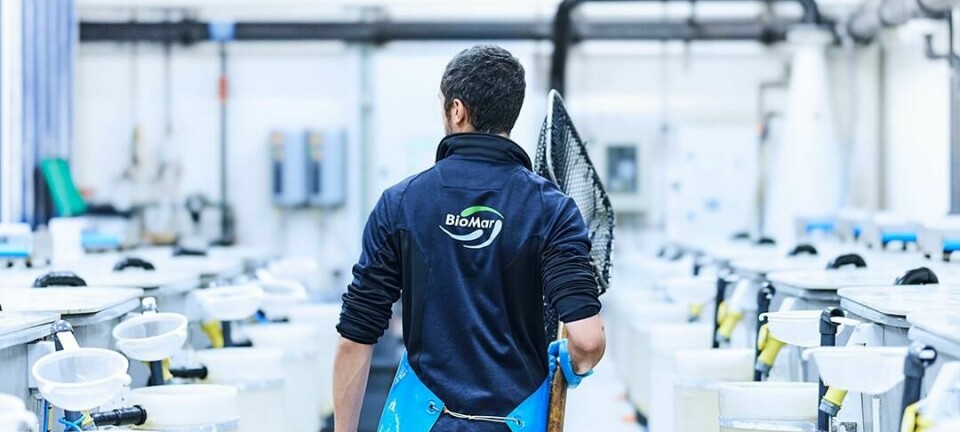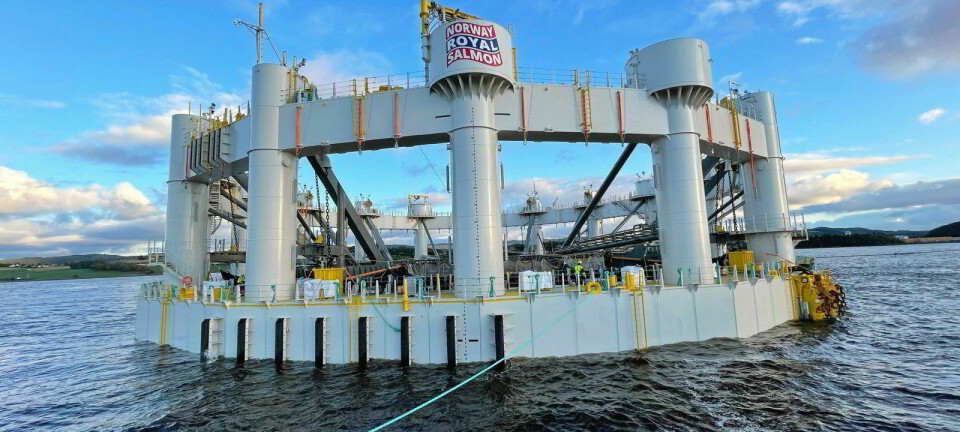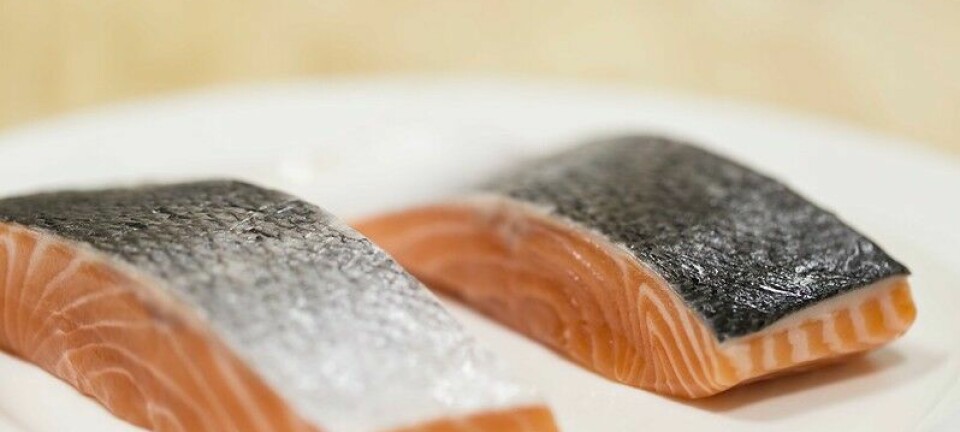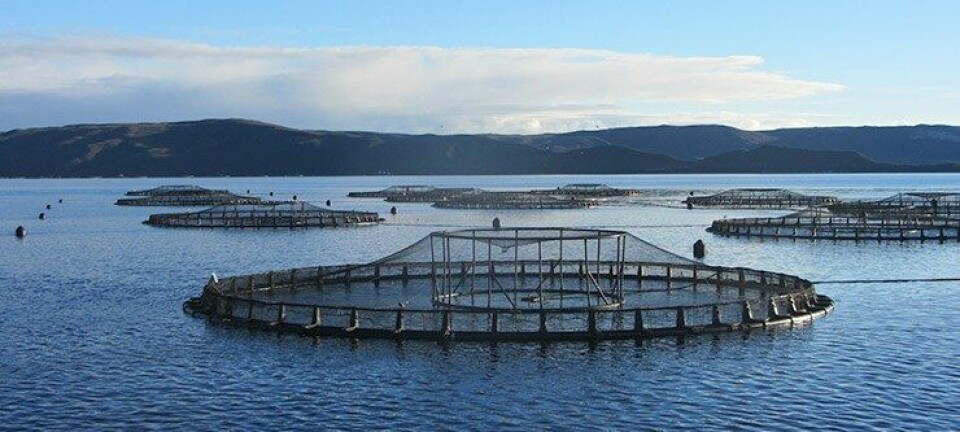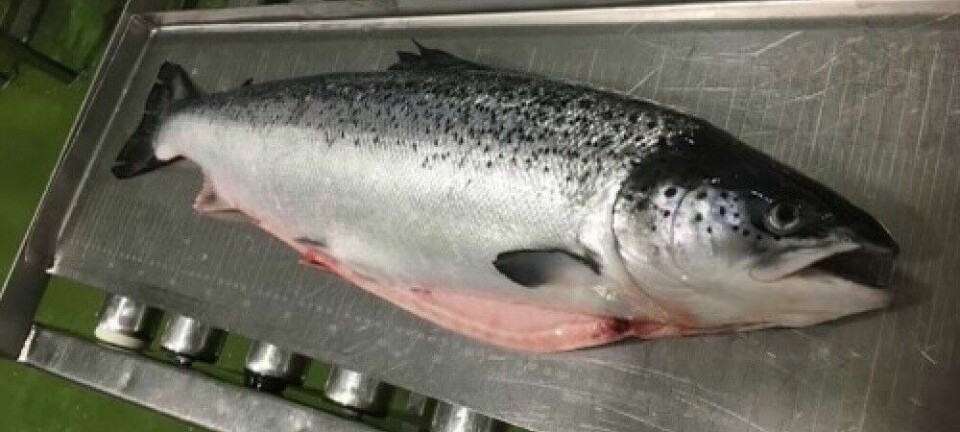“Functional feeds to help restore the balance between Omega 3 and Omega 6”
By Christian Pérez Mallea

Douglas Tocher worked for 16 years for the UK Natural Environment Research Council at the Institute of Marine Biochemistry, Aberdeen, and the Unit of Aquatic Biochemistry, University of Stirling. His main research interests in this period were fish lipid and fatty acid metabolism including embryonic and early larval development, and cell culture studies on eicosanoid metabolism, polyunsaturated fatty acid synthesis and neural development. Since 1998, he has worked at the Institute of Aquaculture, University of Stirling where his primary research interests are the molecular biology and genetic basis of regulation of lipid and fatty acid metabolism and nutrition in fish, with particular focus on omega-3 (n-3) long-chain polyunsaturated fatty acids. In his latest trip to Chile, he participated as speaker during the 2nd edition of the “Jornadas de Invertigación en Salmonicultura”, the largest scientific conference centered in salmon farming in Chile. On that occasion, he spoke about clinical nutrition, polyunsaturated fatty acids (PUFAs), the replacement of marine ingredients with vegetable nutrients and the balance between Omega 3 and Omega 6.
Clinical nutrition is a concept used for several years in human but not in animal nutrition. Can you describe it? Clinical nutrition has several definitions. Some people define it as the nutrition of patients but I regard it more as nutrition with a clinical aim, where the feed or diet is designed to promote good health. That can encompass many different things and I see it as being either specific or non-specific, with the latter being where the feeds do not target any particular disease or pathology.
Clinical nutrition is the approach we take but what we are doing in practical terms is designing functional feeds. It is different to human clinical nutrition since with fish or any farmed animal we are actually producing the entire feed for them. For us, a diet is composed by many different foods while for animals a diet is a particular feed. So, you can put in that feed whatever you believe would be beneficial.
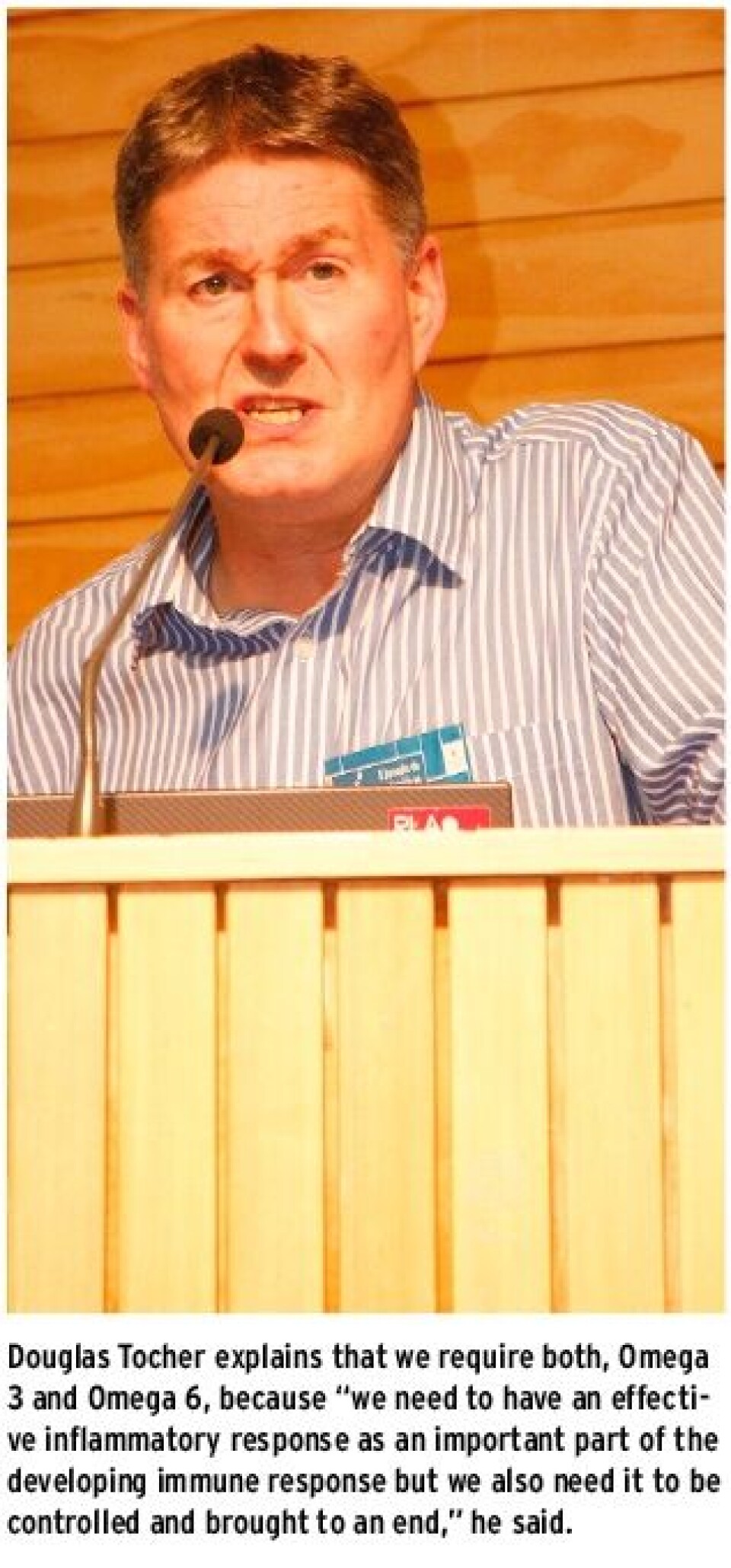
With a relatively non-specific functional feed the formulation can include ingredients that stimulate the immune response or pathway, so the fish will respond better to a pathogen challenge or, for a specific feed, the formulation would be designed to target a specific pathology or pathogen. If you understand a disease and what effect that has, you may be able to design a feed that will particularly help to mitigate the damage caused by that pathogen. You can try to prevent diseases, but obviously with pathogens is not easy to see how just simply changing a feed could actually prevent that animal from catching a specific disease. Even if it cannot prevent the initial infection, once the fish is infected it can still be in better condition to protect itself from the damaging effects of that pathogen.
And what is the specific field you are targeting with Clinical Nutrition in salmon farming? The particular physiological area we have focused on in our work has been to limit and control the inflammatory response, which is the main response of any organism to a pathogen invasion and infection. An acute inflammatory response is an essential component in the reaction to infection by a pathogen. However, if inflammation is uncontrolled and is not resolved (brought to an end) properly when it is no longer required, inflammation can continue too long and, if severe enough, becomes chronic inflammation that can lead to tissue damage. Often it is this inflammatory tissue-damage that is more harmful to the host than the pathogen itself. We have been formulating feeds that are designed help the fish to better control the inflammatory response so it does not become chronic inflammation. This can help to reduce the amount of tissue damage that you may have in response to the pathogen infection.
The particular aspect of the feed that we have been looking at is the balance of long-chain polyunsaturated fatty acids. Long-chain polyunsaturated fatty acids can be one of two types: n-3 or Omega-3 and n-6 or Omega-6. All polyunsaturated fatty acids are essential dietary nutrients but we should also have a balance of Omega-3 to Omega-6 in our diet. The reason we need this balance is because Omega-6 fatty acids promote inflammation whereas Omega-3 tend to be anti-inflammatory and are also very important in resolving inflammatory responses, bringing them to an end.
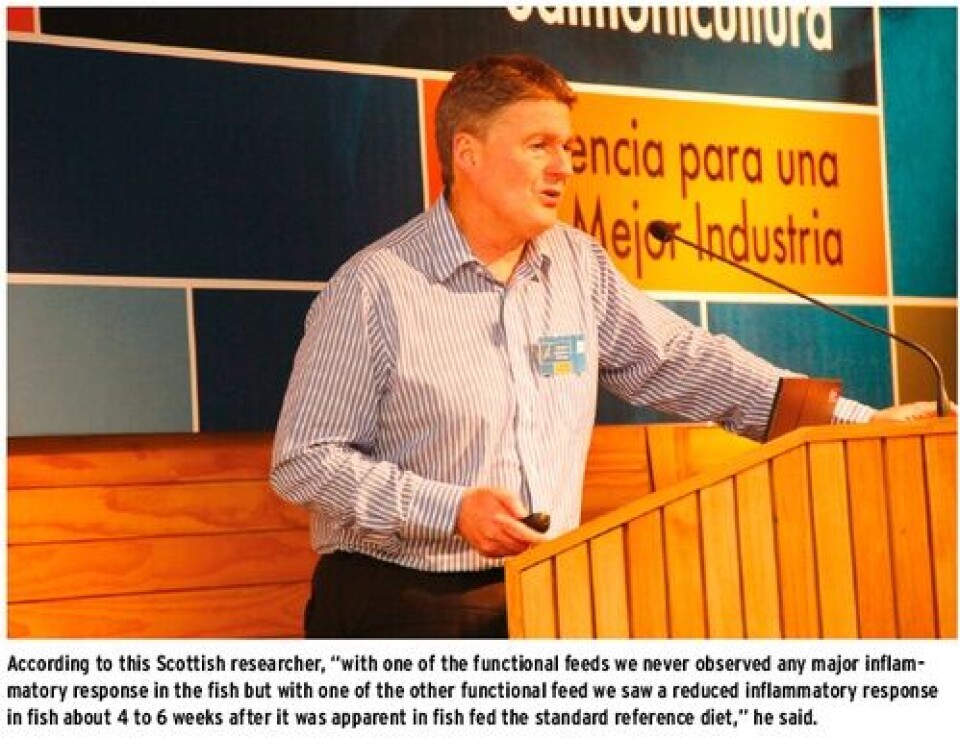
Therefore, both are essential, we require Omega-6 fatty acids because we need to have an effective inflammatory response as an important part of the developing immune response but we also need it to be controlled and brought to an end. So, we need Omega-3 and Omega-6 in balance so that the whole process is controlled.
The situation in humans is that our diet is now very rich in Omega-6. Very much richer than was previously in history and, as a result, the incidence and severity of many inflammatory diseases (for instance, cardiovascular disease as the processes involved are inflammatory responses) are greater than they were in the past and that is why we are suffering a lot more of these diseases. Of course, in humans there is a huge literature on this showing the benefits of eating fish or taking fish oil, rich in long-chain Omega-3, and how this can we can help to restore this balance between Omega-6 and Omega-3 in our diet, and perhaps help alleviate some of these inflammatory diseases. The situation in fish is that they are normally Omega-3 rich and, as long as we are feeding fish oil and fishmeal, they will remain Omega 3 rich but of course there is not enough fish oil and fishmeal in the world to sustain the tremendous growth there is in aquaculture. There is no option but to reduce the levels of fish oil and fishmeal in the feeds and, to do this at the moment, the only alternatives are plant meals and vegetable oils. These terrestrial plant products do not contain long-chain Omega 3 but they can contain quite high levels of Omega-6. Therefore, the dietary balance has been changed and this has the potential to have an influence and a consequence on inflammatory responses in fish.
We have been doing some research to investigate if that is possibly the case and if, by designing functional feeds where we have altered that balance in Omega-3 and Omega-6, restoring a positive Omega-3 to Omega-6 ratio, this helps to alleviate inflammatory damage.
So, I guess you have centered your work in cardiac diseases in fish, such as HSMI and CMS. HSMI and CMS are inflammatory viral diseases meaning they are viruses characterized by inflammatory damage to cardiac tissues. You can also get secondary damage on other tissues as well, muscle and liver for example, but the main effects seem to be focused on cardiac tissue.
This work has been done in collaboration with EWOS Innovation in Norway. Functional feeds were designed that contained higher levels of EPA, one of the important Omega-3 fatty acids and a higher EPA to arachidonic acid ratio. These are two of the main Omega-3 and Omega-6 fatty acids that are involved in the mechanisms of the inflammatory response. What we found was that the functional feeds reduced the inflammatory damage to heart tissue, and we also used transcriptomics (analysis of gene expression) to show that the expression of genes of the immune and inflammatory responses were lower in fish being fed the functional feeds.
The inflammatory response was actually not simply a decreased but also delayed. These feeds were delaying the inflammatory response by a matter of some weeks. With one of the functional feeds we never observed any major inflammatory response in the fish but with one of the other functional feed we saw a reduced inflammatory response in fish about 4 to 6 weeks after it was apparent in fish fed the standard reference diet. These functional feeds were delaying the onset of the response and by looking at gene expression we could see that the inflammatory response was not so strong in the fish being fed the functional feeds. So, the functional feeds had beneficial effects in these inflammatory viral diseases in salmon.
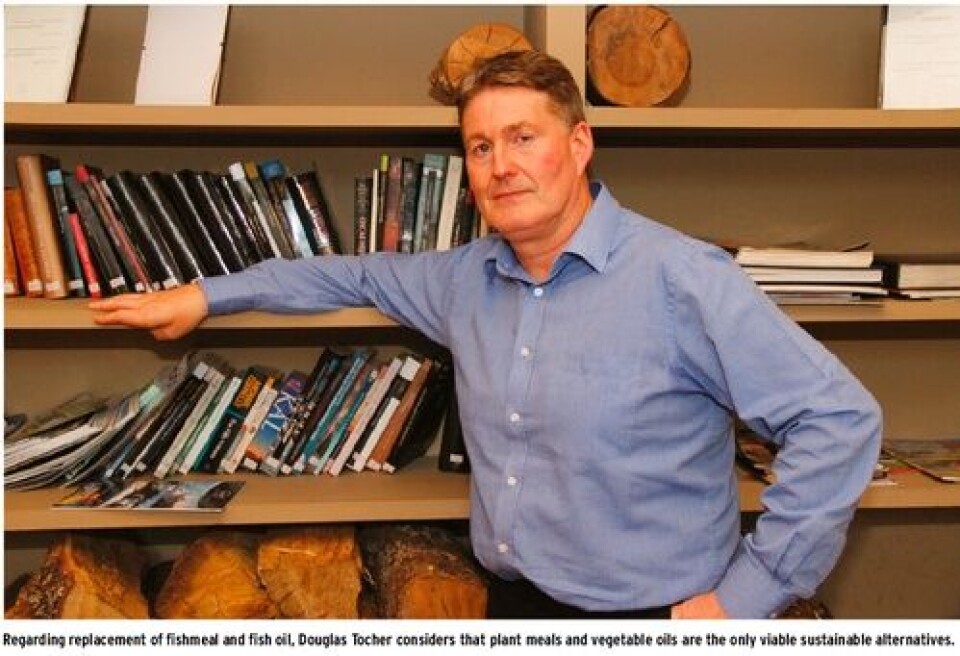
There is usually a lot of concern regarding the human requirements for Omega-3 but what are the metabolic and physiological requirements in fish for these polyunsaturated long-chain fatty acids? Omega-3 are essential dietary nutrients because no vertebrate can produce polyunsaturated long-chain fatty acids. They have to be provided in the diet.
Polyunsaturated fatty acids are fatty acids with two or more double bonds. All organisms are able to make saturated (no double bonds) fatty acids and they are able to insert one double bond but only plants can put in the second or third double bond to make Omega-6 and Omega-3 fatty acids. That is why they are essential for vertebrates. However, depending on the species, dietary polyunsaturated fatty acids can be converted in some vertebrates into other polyunsaturated fatty acids. So there is short-chain (those we can get from plants) and long-chain polyunsaturated fatty acids (those with biological effects in humans and fish, EPA and DHA with 20-22 carbons long and more double bonds).
The long-chain polyunsaturated long-chain fatty acids have various biological effects partly because they are important components of cell membranes and they affect the functioning of many membrane proteins whether they are enzymes that have activity or transporters. In addition to this fundamental role, they can also have metabolic functions including their role in the inflammatory pathway as they are precursors of compounds called eicosanoids. These derivatives of long-chain fatty acids include prostaglandins, leukotrienes, lipoxins, resolvins and protectins that are all intimately involved in the development of the inflammatory response and ultimately in the immune response. So, that is why we were focusing on omega-3 long-chain polyunsaturated fatty acids to control the inflammatory process. These fatty acids also influence gene transcription, so they can affect the production of other important proteins such as cytokines, which are involved in cell-cell communication and signaling and very important in the development of inflammatory and immune responses.
Fish and humans we do not need large amounts of essential fatty acid. About 1% of the diet is all that salmon require of polyunsaturated fatty acids, mainly Omega-3 but with a small amount of Omega-6, to prevent deficiency signs. Therefore, polyunsaturated fatty acids are like vitamins as they cannot be made in the body and, if you do not get enough of a vitamin, you get a deficiency disease. For instance, if you do not get Vitamin C, scurvy is the deficiency disease; and if you do not get enough iron, anemia is the deficiency disease. Similarly, with polyunsaturated fatty acids there is a range of symptoms that are associated with not having enough polyunsaturated fatty acids in your diet. Beyond that small amount to prevent deficiency signs, a larger dietary intake of polyunsaturated fatty acids is probably required to maintain optimal growth and health. This dietary level is to ensure you have enough polyunsaturated fatty acid to maintain all physiological functions at an optimum, and promote good health. Furthermore, as there are at two types of polyunsaturated fatty acids, Omega 3 and Omega 6, there is also the balance between them that is important, which is an added complication that you do not have with vitamins and minerals.
Is there any limitation or maximum recommended consumption of these polyunsaturated fatty acids and a moment when the organisms stops bio accumulating these PUFAs? Salmon and other fish and seafood are our main source of Omega 3 in the human diet. So, there is a third level of long-chain Omega 3 that is important in fish, and that is the level that we want the fish to have to be a good delivery vehicle for Omega-3 to human consumers. We ideally want to maintain the same level of Omega 3 in a farmed fish that you get in a wild fish.
This is a level of dietary Omega 3 beyond what the fish need for their own health and that reflects what happens in the wild. Fish are good sources of Omega 3 because they obtain a large amount of it in their diets in nature, far more than they need for their own metabolism and energy requirements. Therefore, all fish can do, like all of us, is to store excess dietary fat in the body. We need fish to have high levels of Omega 3 in their diet, so that they store the excess and we can obtain it when we consume the fish.
That is why salmon is such a particularly good fish for us, because a lot of fat is stored within the flesh, so when we eat salmon we are also eating its fat stores, whereas other fish like cod store all their fat in the liver. Hence, we can get cod liver oil, but its flesh is lean and, although it is still contains Omega 3 it cannot supply the same dose that salmon can. So, if you are wanting to get a good dose of Omega 3 you get that from eating so-called “oily” fish. Salmon is the best of the farmed fish at that by far. There is no evidence that large amounts of Omega 3 in the diet are harmful for us. Like anything with a lot of double bonds, you need to make sure you have enough antioxidant such as vitamin E.
What do you think are the main effects of nutritional replacement in salmon feeds with vegetable ingredients? This is something that has been forced upon the industry because there is simply is not enough fishmeal and fish oil available in the world. Over the years, around 20 to 25 million tonnes of small pelagic species fish are harvested that reduce to about 6 million tonnes of fishmeal and about 1 million tonne of fish oil. Of course, those levels vary from year to year with environmental factors and can significantly decrease in an “El Niño” year. Therefore, there is only a very finite and limited supply of fishmeal and fish oil and, at the same time, aquaculture is growing all the time, so there is greater and greater demand for fishmeal and fish oil. At the moment, 25 percent of fish oil is going straight into capsules for the direct human consumption market. The use of fishmeal and fish oil for aquaculture peaked about 3 or 4 years ago and, largely because of the amount of replacement taking place in salmon and prawn culture, use in aquaculture is relatively stable at the moment, but we are not going to be able to go back to the days when we were able to feed diets that were completely fishmeal and fish oil. There was nothing intrinsically wrong with this practice as it was common sense. Fish eat fish in the wild and so essentially feeds were being made from fish. The fish could digest this easily and it was relatively cheap but, of course, the latter is not the case now. In particular, there is just not enough fish oil. The main focus is therefore not sustainability. It is simply the fact that there is not enough fishmeal and fish oil and because of that, we have to use something else and at the moment, plant meals and vegetable oils are the only viable sustainable alternatives. What about the negative effects of antinutrients from vegetable ingredients? Plants produce a range of chemicals including some to specifically prevent animals from eating them. Terrestrial animals have largely adapted to these but of course fish have not and so these compounds in plant meals are called antinutritionals because they can affect the efficacy of the feed. However, most plant meals also have another fundamental issue in that they usually have lower protein content than is required in feeds from carnivorous species. Fish like salmon and marine fish like sea bass and sea bream grown in Europe, do not tolerate dietary carbohydrates well as they are not major components in their normal diet. That means that the diet has to have high levels of the other macronutrients, protein and oil. Therefore, protein ingredients must have high protein contents and that often requires plant meals to be concentrated in some form or another. In the process of making concentrates the antinutritionals are often also reduced. For instance, raw soybean meal can have an adverse effect on fish and cause enteritis in the gut but soybean protein concentrate does not have that problem. Antinutritionals are an issue but usually relatively easy to control and they are not restricting the use of plant meals to any great degree.
What is your opinion about novel ingredients with high levels of Omega 3, such as algae and yeast supplements? There are algae products with some obtained from heterotrophic algae produced essentially using fermentation technology. This is producing DHA products primarily used in infant formulae at the moment, so they are quite expensive. There is also a yeast product containing high levels of EPA but, at the moment, the cost of those products is too high for them to be used as macro ingredients in fish feeds. They can be added as supplements to some feeds such as those for marine larval fish but I do not see them as a viable replacement for fish oil at the moment, as they cannot be produced in the volume or at the cost that would make them cost-effective for mass use in fish farming today. They may be in the future if technological advances permit.
But, what about the 1:1 FIFO ratio they claim to achieve with these kind of products? The most important thing about growing any food animal is how efficiently it converts the protein we give it into protein of the animal. In other words, how efficiently a fish converts dietary protein into fish protein in the flesh. Simply put, salmon is more efficient than any terrestrial animal in doing this. That is the most important thing and not the origin of the dietary protein or whether it is from fishmeal or plant meals. Protein is a global commodity. In terms of overall global food security, there is a certain amount of protein in the world that is available for animals to eat, whether the animals are humans or farmed animals, we are all in competition for the available protein. Fishmeal is just one of those protein sources. There is always going to be some fishmeal produced and fish is the best animal to feed that fishmeal to. Some of the major feed producers have already published papers showing that salmon can be net producers of marine protein. However, it is important to emphasise that the most important statistic is that fish faming, especially salmon, is a very efficient animal protein production system.
How do you think your research will be utilized in commercial products in the coming future? We can see in humans the problem that poor or imbalanced diets can cause. I come from Scotland and we are world champions in dying from cardiovascular disease. Diet is one of the factors in the equation. We have a diet that is too fatty and has not enough fish, and we do not take enough exercise.
In aquaculture, up until now, the focus has largely been on feed efficiency and growth rate. Those of course are very important. The industry has to be economic and make a profit but, at the same time, those profits can also be enhanced if we do not lose any fish. It might be that investing in diets that are a little more expensive but focus more on being able to maintain good fish health such that the fish can respond better to pathogen challenges could be beneficial!
I think that this is something that will continue. There is increasing appreciation that a good diet is not simply one that is efficiently digested, provides a good FCR and promotes growth, but is also one that promotes good health and reap rewards as you will have more fish at the end of the day.



